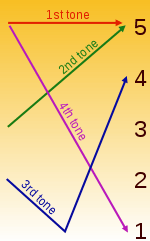Shenyang Mandarin
Shenyang Mandarin (Chinese: 沈阳话) is a dialect of Northeastern Mandarin used by people in and around Shenyang, the capital of Liaoning province and the largest city in Northeast China. It is very close to Standard Chinese but has some notably distinctive words. Some people think of it as a strong accent rather than a distinct dialect. Because of its similarity to the standard language, pinyin can be used to represent the pronunciation.
| Shenyang dialect | |
|---|---|
| 瀋陽話 / 沈阳话 Shěnyánghuà | |
| Native to | China |
| Region | Shenyang |
Sino-Tibetan
| |
| Language codes | |
| ISO 639-3 | – |
cmn-she | |
| Glottolog | shen1252[1] |
However, as schools in Shenyang teach only the standard language, usage of the dialect is dwindling.

The most distinctive aspect of the Shenyang dialect is the much lower pitch of the first tone than in Standard Chinese. It would be positioned at 2, rather than 5, on the chart at right. As a result, it can sound rather like the third tone.
Like Beijing dialect, Shenyang dialect is characterized by erhua (儿化).
Some of the words in Shenyang dialect come from other languages like the Manchu language. One example is 旮旯儿 gālár 'corner'.
Examples of words in various Northeastern dialects (note that these are not specific to Shenyang):
| Northeastern Mandarin | pinyin | Standard Mandarin | Meaning |
|---|---|---|---|
| 不赶趟兒 | bù gǎn tàng r | 赶不上 | unable to catch up |
| 波楞盖儿 | bō lin gàr | 膝盖 | knee |
| 疙瘩、圪塔 | gāda | 地方 | place (noun) |
| 得瑟 | dèse | 卖弄 | to show off |
| 老鼻子(了) | lǎobízi(le) | 很多 | a lot |
| 驲驲地 | rírídi | (形容速度快) | Interjection for increasing speed |
| 埋汰 | máitai | 脏 | dirty |
| 嘎哈 | gāhā | 干什么 、干嘛 | What are you doing? |
| 砢碜 | kēchen (pronounced kezhen) | 不好看 | ugly |
| 老 | lǎo | 很 | very |
| 蚂蛉 | mālíng | 蜻蜓 | dragonfly |
| 嘎赌 | gàdu | 打赌 | to bet |
Phonology
Shenyang dialect has 19 initial consonants, as opposed to 21 in Standard Mandarin. Most notably, retroflex consonants [ʈ͡ʂ], [ʈ͡ʂʰ] and [ʂ] in Standard Chinese are pronounced as [t͡s], [t͡sʰ] and [s], respectively, while [ɻ] is omitted. While lost in Standard Mandarin, Middle Chinese [ɳ] is preserved in Shenyang dialect. [v] exists in Shenyang dialect.[2]
| Labial | Alveolar | Dental sibilants | Palatal | Velar | ||
|---|---|---|---|---|---|---|
| Stops | unaspirated | p | t | t͡s | t͡ɕ | k |
| aspirated | pʰ | tʰ | t͡sʰ | t͡ɕʰ | kʰ | |
| Nasals | m | n | ɳ | |||
| Fricatives | f | v | s | ɕ | x | |
| Approximants | l | |||||
Standard Mandarin diphthongs tend to be pronounced as monophthongs in Shenyang dialect. For example, [ai] becomes [æ], and [au] becomes [ɔ].[2]
References
- Hammarström, Harald; Forkel, Robert; Haspelmath, Martin, eds. (2017). "Shenyang Mandarin". Glottolog 3.0. Jena, Germany: Max Planck Institute for the Science of Human History.
- 孟祥宇 (2011). "沈阳方言音系概说". 语文学刊 (1).